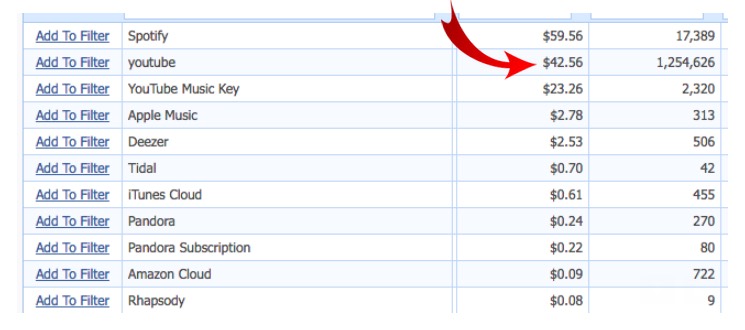How much does YouTube really pay? A top executive at the company claims a $3 CPM. But most of the royalty payments shared with Digital Music News are a tiny fraction of that.
We want to believe YouTube executive Lyor Cohen when he says YouTube pays a $3 CPM to artists. The only problem is that there’s zero evidence to support his claims.
And lots of evidence that artists are earning an infinitesimal fraction of that amount.
The latest proof comes from Nicki Jaine, one half of the duo Revue Noir. That group is signed to Projekt, who shared the royalty breakdown with Digital Music News.
(Quick aside: in online advertising land, ‘CPM’ stands for ‘cost per thousand’. It’s a calculation of how much gets paid for every 1,000 views. So, a ‘$3 CPM’ means you get paid $3 every 1,000 plays. That is, assuming those 1,000 plays had ads on them, which is another story entirely.)
Here’s a quick snapshot of those royalty payments from various streaming services. Keep in mind that these copyrights are 100% controlled, meaning that all publishing and all recording royalties are reflected in this breakdown.

As you can see, a lion’s share of Revue Noir’s payments are coming from free, ad-supported YouTube plays.
Despite 1,254,626 streams on the free platform, Revue Noir only earned $42.56.
Other streaming platforms are clearly paying better, but this group’s largest audience is on YouTube. Strangely, YouTube Red’s payments are far higher, but barely anyone is paying for Red. (The premium service was initially called ‘Music Key,’ and apparently not updated in this royalty statement).
Other platforms like Rhapsody, Tidal, and Spotify pay far better. But the group hasn’t been able to secure favorable playlist inclusion or amass a serious audience on those platforms. At least not yet. So it basically sucks to be them right now.
As a result, the group earned about $130 in total from nearly 1.3 million streaming plays.
In terms of the YouTube CPM calculation, that boils down to a 3.34 cent CPM. Which is about 1/88th the $3 CPM claimed by executives like Lyor Cohen.
Projekt CEO Sam Rosenthal is obviously disappointed with this result. “Spotify has 1.3% of the plays of YouTube, and yet it generates 40% more money,” Rosenthal told DMN.
“Well — that’s shitty!”
Rosenthal was also careful to clarify that this is a 100% copyright-owned composition. Meaning, all the revenues are reflected in this statement.
“And because somebody will say, ‘Oh, that’s because the label is screwing the artist out of their fair share’:
(1) I am the label
(2) The numbers above are the raw data from my digital distributor, before anyone takes their cut!”
The sad payout is even worse than a detailed breakdown we received in August. That YouTube statement showed an artist making 1/50th the rate claimed by YouTube and Cohen.
All of which is seriously eroding the credibility of executives like Cohen, and YouTube more broadly.
Unsurprisingly, the music industry is strategizing ways to minimize YouTube’s power over artists.
Just recently, Republic Records-signed rapper Post Malone decided to withhold his latest single from the video platform. Instead, Malone uploaded a looping chorus of his track ‘rockstar,’ while directing fans to check out the full song on other platforms.
Malone’s little idea worked. So far, the song has more than 50 million plays on YouTube — and more than 150 million on Spotify. Other platforms like Apple Music were also prominently featured as redirect options, leading to millions in diverted royalties.
Post Malone is easily one of the biggest rappers in the world right now. That makes this a noteworthy experiment, and one that could start a trend among other artists eager to divert fans to better-paying platforms.
Separately, a number of companies are also assisting artists to realize revenues elsewhere. That includes upstarts like Flattr, Songtradr, and Patreon, all of whom are focusing on dramatically improving artist incomes.
[Blogger’s Note: The exact same thing is happening with Kindle authors on Amazon who enroll their ebooks in the Kindle Online Lending Library. Subscriptions accumulate to Amazon, royalties trickle to authors.]
